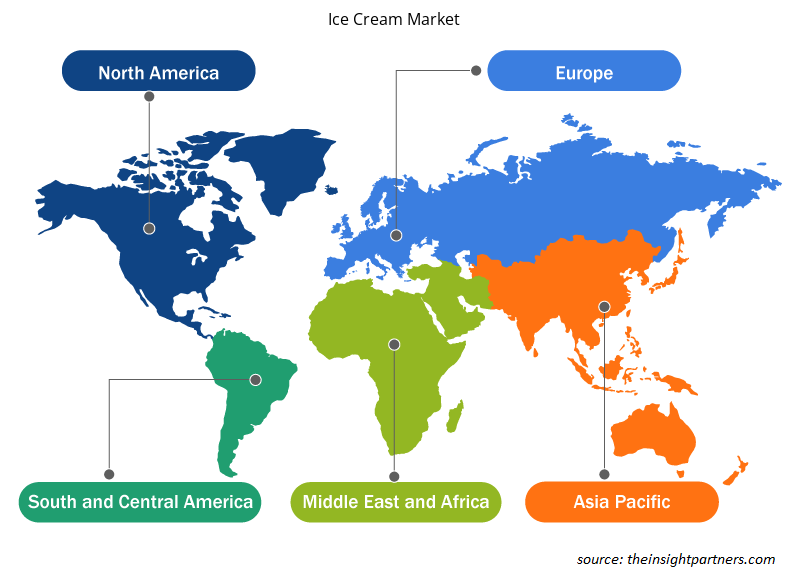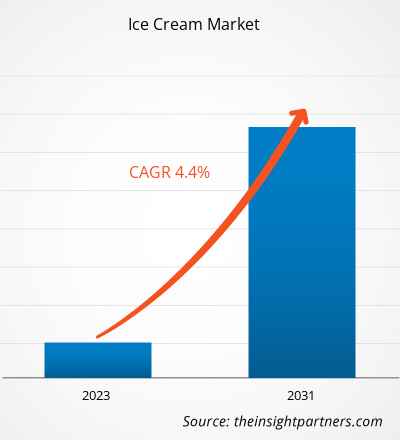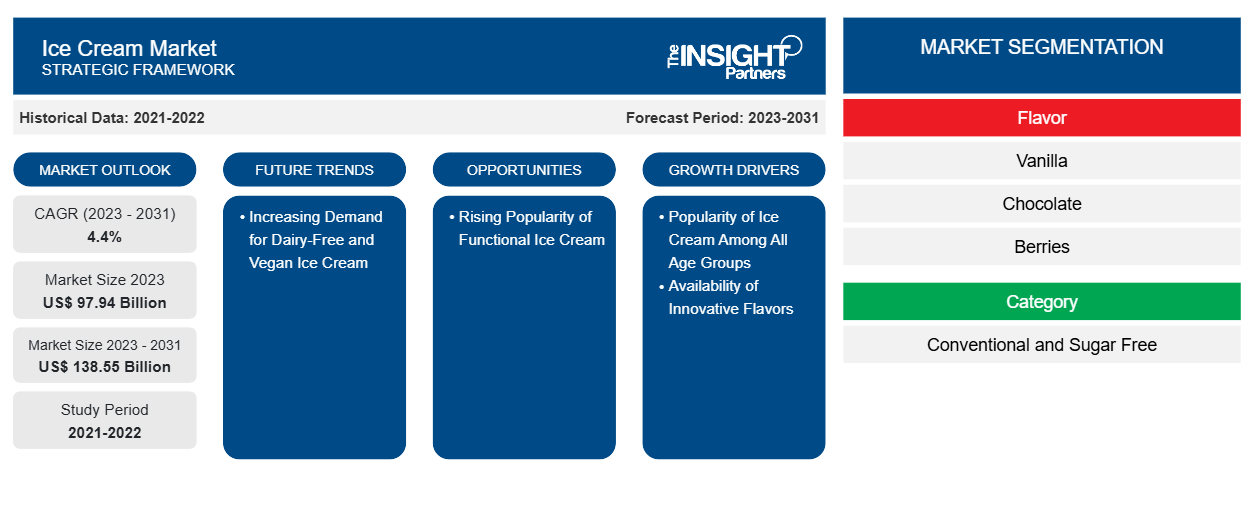Si prevede che la dimensione del mercato del gelato raggiungerà i 138,55 miliardi di dollari entro il 2031, rispetto ai 97,94 miliardi di dollari del 2023. Si prevede che il mercato registrerà un CAGR del 4,4% nel periodo 2023-2031. È probabile che la crescente domanda di gelato vegano e senza latticini agisca come una tendenza chiave nel mercato.
Analisi del mercato del gelato
L'aumento della domanda di gelati di qualità, la disponibilità di vari gusti e l'aumento della preferenza per ingredienti naturali e senza conservanti sono tra i fattori che guidano la crescita del mercato dei gelati . La domanda di gelati naturali magri, con un gusto elevato e appagante è in aumento in Europa. La crescente preferenza per i dessert congelati come aiuto digestivo dopo i pasti aumenta la domanda di queste prelibatezze. Il crescente interesse dei produttori di gelati per l'arricchimento e l'aggiunta di ingredienti funzionali può influenzare la decisione del consumatore di selezionare un'alternativa sana. Oltre alla nutrizione di base, il cibo funzionale offre vantaggi che possono aiutare a ridurre o prevenire il rischio di alcune malattie. Inoltre, i gelati funzionali senza zucchero e magri stanno guadagnando un'enorme popolarità grazie ai loro benefici per la salute.
Panoramica del mercato del gelato
Il gelato è un dessert popolare ed è disponibile in vari gusti. La crescita del mercato del gelato è guidata dalla disponibilità di gelati aromatizzati, in particolare gusti di frutta di stagione, e dall'aumento delle innovazioni di gusto da parte dei produttori. Di recente, il gelato funzionale è diventato popolare tra i consumatori attenti alla salute in quanto contiene ingredienti di alta qualità e soddisfa i requisiti nutrizionali dei consumatori più del gelato normale. Quindi, il crescente interesse dei produttori di gelato per l'arricchimento e l'aggiunta di ingredienti funzionali può influenzare la decisione del consumatore di selezionare un'alternativa sana. Inoltre, i gelati funzionali senza zucchero e a basso contenuto di grassi stanno guadagnando un'enorme popolarità grazie ai loro benefici per la salute. Tra i principali attori del mercato dei gelati figurano Blue Bell Creameries, Unilever Plc, Nestle SA, General Mills Inc, Mars Inc, Wells Enterprises, Turkey Hill Dairy, Dairy Farmers of America Inc, Cold Stone Creamery, Morinaga Milk Industry Co Ltd, Kwality Foods LLC, Baskin-Robbins, David Chapman's Ice Cream Limited, Lotus Bakeries NV e IMURAYA GROUP CO., LTD.
Personalizza questo report in base alle tue esigenze
Riceverai la personalizzazione gratuita di qualsiasi report, comprese parti di questo report, o analisi a livello nazionale, pacchetto dati Excel, oltre a usufruire di grandi offerte e sconti per start-up e università
-
Scopri le principali tendenze di mercato in questo rapporto.Questo campione GRATUITO includerà analisi di dati che spaziano dalle tendenze di mercato alle stime e alle previsioni.
Driver e opportunità del mercato del gelato
Disponibilità di gusti innovativi
I produttori di gelato stanno sviluppando prodotti con componenti nutrizionali, ripieni di erbe biologiche e aromi esotici nella formulazione del prodotto per ottenere un vantaggio competitivo e attrarre più consumatori. I produttori stanno introducendo aromi esotici come cocco, limone e frutti tropicali per adattarsi alle mutevoli preferenze di gusto dei consumatori. Inoltre, i consumatori sono preoccupati per la loro salute. Pertanto, i produttori stanno modificando gli ingredienti utilizzati nei prodotti in base alle preferenze dei consumatori e introducendo nuovi prodotti per differenziare le loro offerte. Ben & Jerry's ha lanciato un gelato con additivi CBD. Inoltre, il gelato al liquore sta guadagnando popolarità negli Stati Uniti. Questi prodotti contengono meno dello 0,5% di alcol; pertanto, sono ampiamente venduti al dettaglio nei negozi di alimentari e specializzati. A settembre 2021, Häagen-Dazs ha lanciato un gelato infuso di alcol con un gusto di cinque pinte tradizionali a base di crema irlandese, rum, bourbon e stout. Inoltre, a novembre 2023, LiQ e Baileys hanno stipulato un accordo di partnership per lanciare praline di gelato infuse di liquore.CBD additives. Further, liquor ice cream is gaining popularity across the US. These products contain less than 0.5% alcohol; therefore, they are widely retailed in grocery and specialty stores. In September 2021, Häagen-Dazs launched a spirit-infused ice cream with a flavor of five traditional pints made with Irish cream, rum, bourbon, and stout. In addition, in November 2023, LiQ and Baileys entered into a partnership agreement to launch liquor-infused ice cream pralines.
Crescente popolarità del gelato funzionale
La popolarità del gelato funzionale è principalmente guidata dalle innovazioni di prodotto, soprattutto in termini di profilo del gusto e valore nutrizionale. Ad agosto 2022, il marchio di gelato cult della California e preferito dalle celebrità Coolhaus ha fatto il suo debutto a Singapore con sei gusti. Questi lanci di prodotti funzionali aiutano i consumatori a seguire e mantenere i propri obiettivi di salute e a godersi un buon pasto contemporaneamente, poiché la salute è diventata una priorità per i consumatori durante la crisi del COVID-19. Da quando le persone hanno iniziato a concentrarsi sui prodotti alimentari pronti mantenendo l'equilibrio nutrizionale nella loro dieta, i produttori stanno lanciando gelati arricchiti dal punto di vista nutrizionale. Tali innovazioni di prodotto li aiutano ad ampliare la loro portata e ad acquisire un vantaggio competitivo nei mercati regionali. Pertanto, si prevede che la crescente domanda di gelati funzionali creerà opportunità redditizie per il mercato dei gelati nei prossimi anni.Coolhaus made its debut in Singapore with six flavors. These launches of functional products help consumers follow and maintain their health goals and enjoy a good meal simultaneously, as health became a priority for consumers during the COVID-19 crisis. Since people have started focusing on convenience food products while maintaining the nutritional balance in their diets, manufacturers are launching nutritionally enriched ice creams. Such product innovations help them extend their reach and gain a competitive edge in regional markets. Thus, the rising demand for functional ice creams is expected to create lucrative opportunities for the ice cream market in the coming years.
Analisi della segmentazione del rapporto sul mercato del gelato
I segmenti chiave che hanno contribuito alla derivazione dell'analisi del mercato del gelato sono gusto, categoria, forma e canale di distribuzione.
- In base al gusto, il mercato del gelato è segmentato in vaniglia, cioccolato, frutti di bosco, matcha e altri. Il segmento del cioccolato ha detenuto la quota di mercato maggiore nel 2023.
- Per categoria, il mercato è diviso in convenzionale e senza zucchero. Il segmento convenzionale deteneva una quota maggiore del mercato nel 2023.
- In termini di forma, il mercato è segmentato in tazze e vaschette, barrette e bastoncini e altri. Il segmento tazze e vaschette ha dominato il mercato nel 2023.
- In base al canale di distribuzione, il mercato del gelato è segmentato in supermercati e ipermercati, negozi specializzati, vendita al dettaglio online e altri. Il segmento supermercati e ipermercati ha detenuto la quota di mercato maggiore nel 2023.
Analisi della quota di mercato del gelato per area geografica
L'ambito geografico del rapporto sul mercato del gelato è suddiviso principalmente in cinque regioni: Nord America, Asia Pacifico, Europa, Medio Oriente e Africa, Sud e Centro America.
Nel 2023, l'Asia Pacifica ha detenuto la quota maggiore del mercato dei gelati. La disponibilità di vari gusti di gelati, in particolare gusti di frutta di stagione, e le innovazioni di gusto da parte dei produttori guidano il mercato dei gelati nell'Asia Pacifica. Inoltre, si prevede che l'inclinazione dei consumatori verso i prodotti a base vegetale dovuta alla crescente adozione di prodotti più sani creerà nuove tendenze di gelati a base vegetale e vegani nel mercato dei gelati dell'Asia Pacifica durante il periodo di previsione. La crescente domanda di gelati vegani ha portato all'innovazione e al lancio di gelati a base vegetale nella regione. Ad esempio, a novembre 2023, OATSIDE, un produttore di latte d'avena di Singapore, ha introdotto una linea di gelati vegani in tre gusti disponibili presso i principali rivenditori a livello nazionale. Anche l'aumento del reddito disponibile, la rapida urbanizzazione e l'aumento degli standard di vita spingono la crescita del mercato dei gelati. I consumatori cercano anche alimenti più sani e nutrienti, il che porta a una maggiore domanda di gelati con probiotici, prebiotici e ingredienti funzionali.
Approfondimenti regionali sul mercato del gelato
Le tendenze regionali e i fattori che influenzano il mercato del gelato durante il periodo di previsione sono stati ampiamente spiegati dagli analisti di Insight Partners. Questa sezione discute anche i segmenti e la geografia del mercato del gelato in Nord America, Europa, Asia Pacifico, Medio Oriente e Africa, e Sud e Centro America.

- Ottieni i dati specifici regionali per il mercato del gelato
Ambito del rapporto sul mercato del gelato
| Attributo del report | Dettagli |
|---|---|
| Dimensioni del mercato nel 2023 | 97,94 miliardi di dollari USA |
| Dimensioni del mercato entro il 2031 | 138,55 miliardi di dollari USA |
| CAGR globale (2023-2031) | 4,4% |
| Dati storici | 2021-2022 |
| Periodo di previsione | 2023-2031 |
| Segmenti coperti |
Per sapore
|
| Regioni e Paesi coperti |
America del Nord
|
| Leader di mercato e profili aziendali chiave |
|
Densità degli attori del mercato del gelato: comprendere il suo impatto sulle dinamiche aziendali
Il mercato del gelato sta crescendo rapidamente, spinto dalla crescente domanda degli utenti finali dovuta a fattori quali l'evoluzione delle preferenze dei consumatori, i progressi tecnologici e una maggiore consapevolezza dei benefici del prodotto. Con l'aumento della domanda, le aziende stanno ampliando le loro offerte, innovando per soddisfare le esigenze dei consumatori e capitalizzando sulle tendenze emergenti, il che alimenta ulteriormente la crescita del mercato.
La densità degli operatori di mercato si riferisce alla distribuzione di aziende o società che operano in un particolare mercato o settore. Indica quanti concorrenti (operatori di mercato) sono presenti in un dato spazio di mercato in relazione alle sue dimensioni o al valore di mercato totale.
Le principali aziende che operano nel mercato del gelato sono:
- Cremerie Blue Bell
- Società per azioni Unilever
- Nestlé SA
- General Mills Inc
- Marte Inc.
- Imprese di pozzi
Disclaimer : le aziende elencate sopra non sono classificate secondo un ordine particolare.

- Ottieni una panoramica dei principali attori del mercato del gelato
Notizie e sviluppi recenti sul mercato del gelato
Il mercato del gelato viene valutato raccogliendo dati qualitativi e quantitativi dopo la ricerca primaria e secondaria, che include importanti pubblicazioni aziendali, dati associativi e database. Di seguito sono elencati alcuni degli sviluppi nel mercato del gelato:
- Blue Bell Creameries ha ampliato la sua area di distribuzione per includere St. Louis e le città limitrofe a partire da marzo 2024. Un impianto di distribuzione di 16.000 piedi quadrati è in costruzione al 11400 Spencer Road a St. Peters, Missouri. Nessun prodotto verrà realizzato in loco, ma ci sarà una cella frigorifera per i dolcetti congelati. Blue Bell utilizza la consegna diretta in negozio, assicurando che solo i suoi dipendenti gestiscano il prodotto dalla produzione agli scaffali del negozio. (Fonte: Blue Bell Creameries, sito Web aziendale, novembre 2023)
- Magnum ha lanciato una confezione multipla di gelato vegano in formato mini e una ricetta nuova e migliorata per la sua gamma base vegana. (Fonte: Unilever Plc, comunicato stampa, gennaio 2023)
Copertura e risultati del rapporto sul mercato del gelato
Il rapporto "Dimensioni e previsioni del mercato del gelato (2021-2031)" fornisce un'analisi dettagliata del mercato che copre le seguenti aree:
- Dimensioni e previsioni del mercato del gelato a livello globale, regionale e nazionale per tutti i principali segmenti di mercato coperti dall'ambito
- Tendenze del mercato del gelato, nonché dinamiche di mercato come fattori trainanti, limitazioni e opportunità chiave
- Analisi dettagliata delle cinque forze di Porter e SWOT
- Analisi del mercato del gelato che copre le principali tendenze del mercato, il quadro globale e regionale, i principali attori, le normative e i recenti sviluppi del mercato
- Analisi del panorama industriale e della concorrenza che copre la concentrazione del mercato, l'analisi della mappa di calore, i principali attori e gli sviluppi recenti per il mercato del gelato
- Profili aziendali dettagliati
- Analisi storica (2 anni), anno base, previsione (7 anni) con CAGR
- Analisi PEST e SWOT
- Valore/volume delle dimensioni del mercato - Globale, Regionale, Nazionale
- Industria e panorama competitivo
- Set di dati Excel
Report recenti
Testimonianze
Motivo dell'acquisto
- Processo decisionale informato
- Comprensione delle dinamiche di mercato
- Analisi competitiva
- Analisi dei clienti
- Previsioni di mercato
- Mitigazione del rischio
- Pianificazione strategica
- Giustificazione degli investimenti
- Identificazione dei mercati emergenti
- Miglioramento delle strategie di marketing
- Aumento dell'efficienza operativa
- Allineamento alle tendenze normative























 Ottieni un campione gratuito per - Mercato del gelato
Ottieni un campione gratuito per - Mercato del gelato